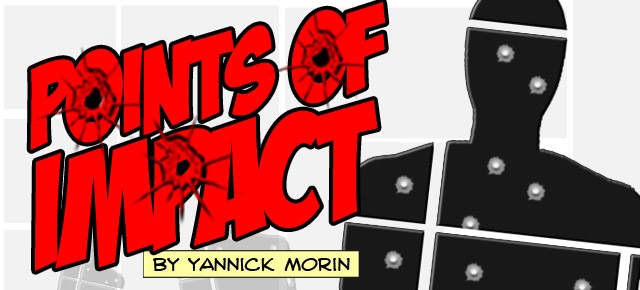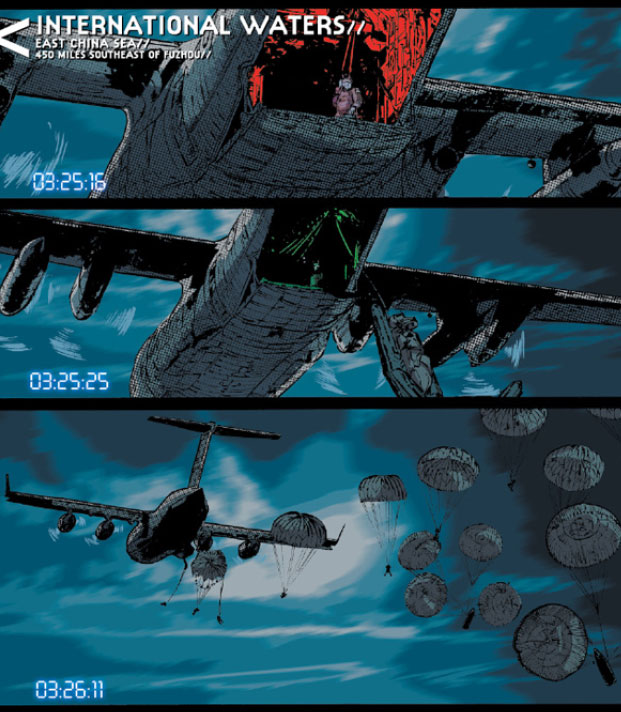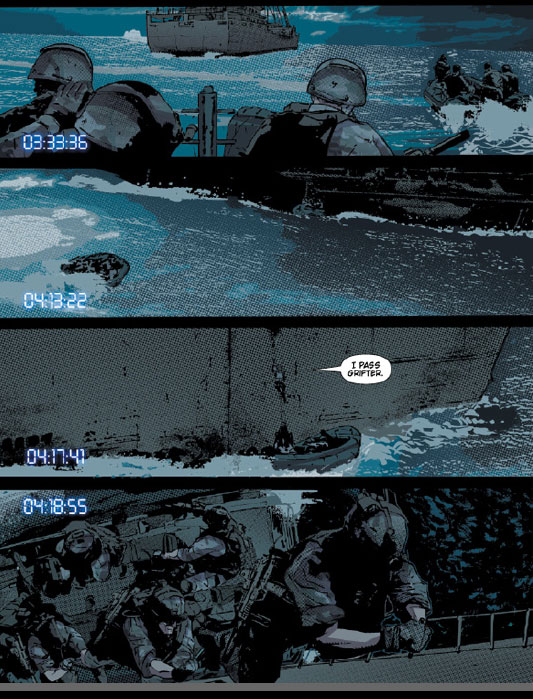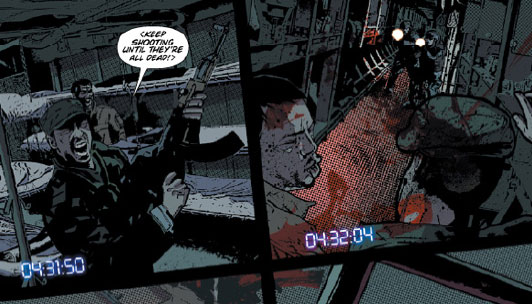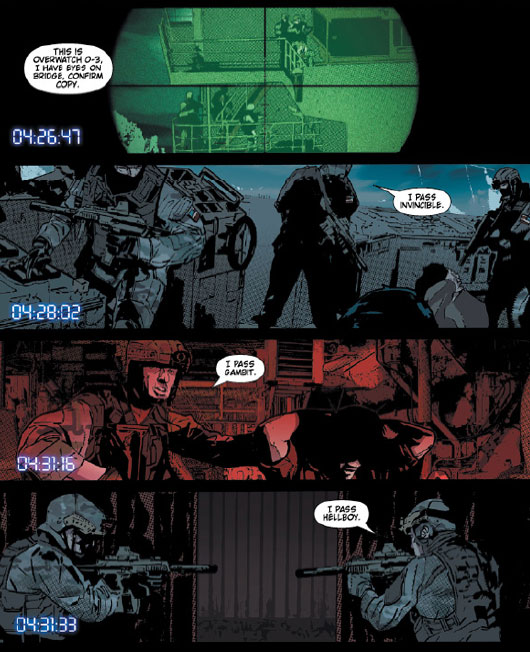Points of Impact – Week 17: Time After Time
1st Disclaimer: Points of Impact contains so many spoilers it can practically replace reading your comics. Know what that means? Read your comics first!
2nd Disclaimer: For the sake of simplicity and since it’s impossible for me to know exactly who did what for the specific elements I usually examine, unless the creators come forward themselves to set me straight, from now on I’ll assume that everything in the comic stems from a joint decision by both the artist and the writer. I figure I’ll get it right most of the time if I give each 50% of the credit. I apologize in advance if I’m off from time to time, but I’d rather give too much credit than not enough where it’s due.
The explicit time flow in Nathan Edmondson and Mitch Gerads’ THE ACTIVITY #7
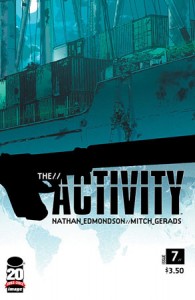 Story: Nathan Edmondson
Story: Nathan Edmondson
Art: Mitch Gerads
Color assistant: Joseph Frazzetta
Letterer: Jeff Powell
What?! Nathan Edmondson again?
Yes, again. I can’t help if if the man has a comic out two weeks in a row, has some solid writing chops and also works with magically-talented artists. That’s his very special curse and he’ll have to live with it. But don’t worry: Edmondson is the only thing from last week that will get repeated this week. If last time we were talking about location, today we’ll be examining time and how it can be manipulated in comics.
Like location, time is one of the great invisible constants of sequential arts, even more so thanks to its inherently intangible nature. You can’t draw time and you can’t have your characters run around it. Another comparison we can draw with location, time is also often taken for granted. It gets mentioned once, in a fleeting caption – “meanwhile”, “later that night” or “ten years ago” – and then it’s promptly forgotten. After all, is’t it closure’s* job to manage the flow of time between the panels? In a certain measure, it’s the type of transition used that will determine how closure will work its magic.
*Closure is the automatic semi-conscious process that lets the reader make sense of the transitional space between panels, according to Scott McCloud (Understanding Comics). Yes, I cribbed this from Week 13.
But what happens if, instead of leaving most of the work to closure, the creators supplement every transition with a time caption?
Edmondson and Gerads’ THE ACTIVITY #7 provides some interesting answers with its opening scene. Instead of opening on series regular Team Omaha, the story thrusts us into the international waters of the China Sea as Navy SEALs mount a covert assault on a Chinese freighter which we’ll suppose crewed by terrorists. What’s interesting with this opening is that Edmondson and Gerads have included a time stamp on every panel that’s part of this scene. We’re talking of seven full pages with 32 separate captions with no other function than to announce the time.
Or is that their only function? We can dig deeper by examining five different samples, each demonstrating the use of a specific type of transition. In other words, we’re going to look at five different ways to achieve closure and how the captions that were included can have an impact on those.
We’ll be using the same order as in McCloud’s Understanding Comics so our first example will be a moment-to-moment transition. This type of transition occurs when the camera stays focused on a single subject, simply showing what happens to it without the artifice of any narrative shortcuts. The example we’ll examine is taken from the very first page, as the American plane drops the SEALs and their equipment into the sea.
Notice how the camera stays focused on the plane as each panel decomposes the action – the drop – into static images. Furthermore, see how narrow the time gaps are between the time stamps: no more than a minute all in all, with the shortest gap being 9 seconds. Coupled with this type of transition, the amount of progress shown during that time span conveys to the reader the idea of efficiency.
Next up is an action-to-action transition: the SEALs are quietly approaching h the target ship.
This time, the camera moves around , even though it’s still focusing on the same subject. The factor that makes this an action-to-action transition instead of a moment-to-moment one is that the panels show the SEALS going through a series of actions instead of just showing one action cut down into snapshots. Another difference: this time, the time stamps are substantially farther apart. This signifies a careful and stealthy approach, something that would be next to impossible to convey without the time stamps there to underline precisely how fast – or not – time is passing.
Now let’s have a look at a subject-to-subject transition: as the American attack, the Chinese try to set up some kind of resistance effort – a short-lived one but still…
Here we have the camera switching from one active subject to another inside the same scene: first the bad guys trying to encourage themselves and then the Navy SEALs cutting them down. There’s a 14-second difference between the first panel and the second one: that’s not a long time to live for the guys getting their hopes up. In this case, the time stamps convey a sense of suddenness.
Then we have some scene-to-scene transitions as we watch different groups of soldiers call out their status reports – very original ones, might I add.
The camera now switches from one location to the next, the time stamps indicating that we’re always moving forward in time; these are not simultaneous events. Indeed, the gaps go from mere seconds to a couple of minutes. Together, transitions and time captions give the reader a sense of the length and complexity of the operation. Once more, this is not something that could have been conveyed so precisely with the panel transitions alone. It would have been easy to conclude that all of these scenes took place at once.
Finally, we’re going to have a look at an aspect-to-aspect transition: after an establishing shot of the USS Chafee, we switch views to its control room where two officers discuss the choice of code words for the mission.
Notice that there’s no time jump here: the time stamps are exactly the same from one panel to the next. Since it’s a silent establishing shot followed by the corresponding interior shot – there’s no action depicted in the first panel – it goes to reason that time doesn’t move. In a certain way, establishing shots when done in this fashion inherently constitute the first panel of an aspect-to-aspect transition, that is a sequence of shots describing a location, all condensed in the same timeless moment.
Having examined the time stamps and the role they played in five different types of transitions, what can we now conclude?
It’s tempting to say that these time stamps are replacing closure in that they tell the reader how to interpret the transition between panels. However, visual clues abound to make sure closure occurs enven without theses captions. There’s no non sequitur here! No, what the time stamps actually accomplish is that they assume complete control over the flow of time inside the story. As such, they act as in-story structures that actively enforce a certain pacing.
Hence, in the grammar that is the the comic language, the time stamps fill the role of adverbs to the transitions’ verbs:
- they qualify what’s already implied;
- they provide additional meaning to the reader’s interpretation;
- they enrich the bare mechanisms (transitions) without being able to replace them entirely.
Thus, for their enlightening use of time indicators, Nathan Edmondson and Mitch Gerads score a BULLSEYE with THE ACTIVITY #7.
Lesson Learned
Closure is an automatic given as soon as you line up two panels; it will emerge from any transition. However, that doesn’t mean you can just serve it up straight. By using time stamps and thus taking direct control over the in-story pacing, you can conjure up qualifiers to the transitions that will contribute in modifying how the reader interprets the narrative.
Honorable Mentions
- Terry Moore does it again in RACHEL RISING #9 when he uses some space to insert a silent panel in order to accomodate a beat that was necessary to the action. Tell you what, I’ll give the same kudos to Nathan Edmondson and Mitch Gerads because they show their understanding of this notion in THE ACTIVITY #7 as well.
- In ELEPHANTMEN #41, David Hine demonstrates a very interesting use of a subjective viewpoint.
- Brian K. Vaughan and Fiona Staples continue to impress with SAGA #5, especially thanks to their mastery of scene-to-scene transitions.
- SKULLKICKERS #16 by Jim Zub and Edwin Huang was a pure delight. I especially liked the way the panel grid was rotated to fit the characters’ viewpoint.
Dishonorable Mentions
- Bobby Cornow and Dave Wachter stumble on their way out of NIGHT OF 1,000 WOLVES #3 of 3. They set up the “rules” of their story a little too late for them to support their ending.
- THE DARKNESS #105 does the opposite of what RACHEL RISING #9 accomplished: David Hine and Jeremy Haun skip a whole beat at some point, with this hiccup making for an unpleasant bump in an otherwise smooth road. But they’re not alone: Robert Place Napton and Carlos Rafael veered into that same pothole in WARLORDS OF MARS: DEJAH THORIS #13.
- Ron Marz and Walter Geovani have a bunch of characters standing around and contributing nothing to the story in PROPHECY #2. This is a classic example of too large a cast for too small a plot. Special mention goes to Pantha who said one line and then stuck to the background.
- RED SONJA #67 has us drowning in excessive narration that reveals everything, from thoughts to emotions to motivations. Eric Trautmann and Marcio Abreu should take a page from Brian Wood’s CONAN THE BARBARIAN for ongoing narration that complements the action instead of hindering it.
That’s it! Come back in a week and I’ll have more Points of Impact for you!
Please click here to make comments in the forum!
Related Posts:
Category: Columns, Points Of Impact

